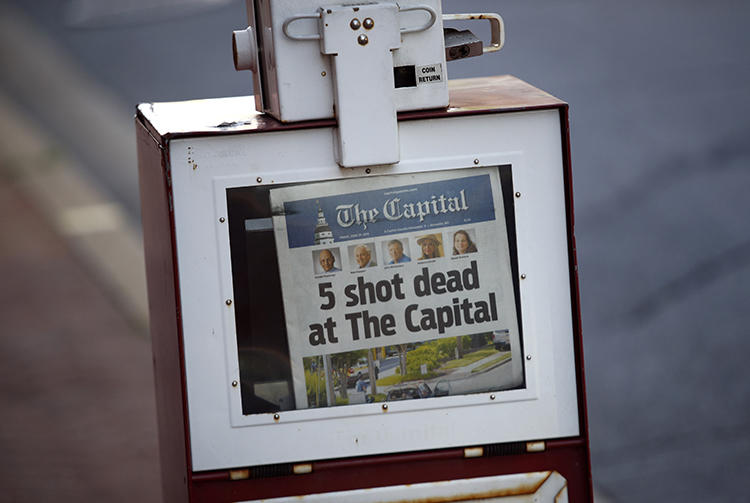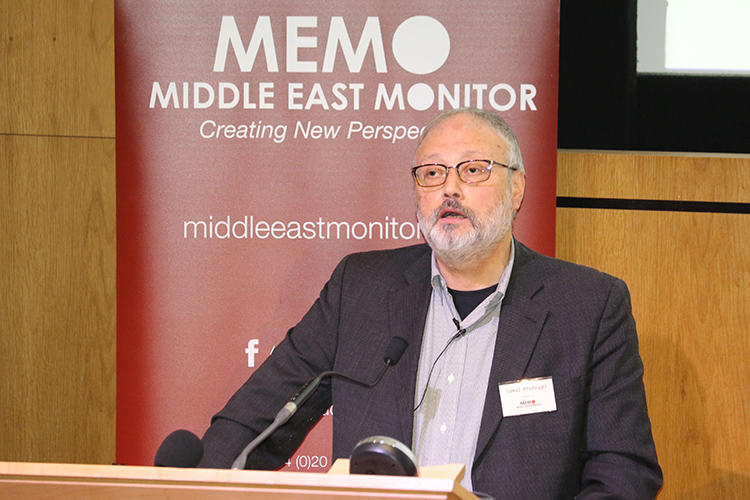Journalists from Saudi Arabia to Afghanistan to the U.S. were targeted for murder in 2018 in reprisal for their work, bringing the total of journalists killed on duty to its highest in three years. The number of journalists killed in conflict fell to its lowest level since 2011. A CPJ special report by Elana Beiser
Video: Murders of Journalists Rise in 2018
Published December 19, 2018
NEW YORK
The number of journalists targeted for murder in reprisal for their reporting nearly doubled in 2018 from a year earlier, driving up the overall count of journalists killed on the job. Afghanistan, where extremists have stepped up deliberate attacks on journalists, was the deadliest country and accounted for much of the increase.
At least 53 journalists were killed around the world between January 1 and December 14, 2018, of which at least 34 were singled out for murder. CPJ tracks three types of journalists’ deaths on the job: reprisal murders; deaths in combat or crossfire (11 this year, the lowest since 2011); and deaths on other dangerous assignments, such as covering protests that turn violent (eight this year). The total is up from 47 killed in all of last year, of which 18 were pinpointed for murder. A total of 50 were killed in 2016.
The recent uptick in killings follows two years of decline, but comes as the jailing of journalists hits a sustained high–adding up to a profound global crisis of press freedom. The context for the crisis is varied and complex, and closely tied to changes in technology that have allowed more people to practice journalism even as it has made journalists expendable to the political and criminal groups who once needed the news media to spread their message.
Another significant factor is a lack of international leadership on journalists’ rights and safety.
The most illustrative case is the brazen murder of Washington Post columnist Jamal Khashoggi in the Saudi Arabian consulate in Istanbul in October by Saudi agents. Khashoggi, who lived in self-imposed exile in the U.S., had been strongly critical of Saudi Crown Prince Mohammed bin Salman. The most vocal head of state in Khashoggi’s case has been Turkish President Recep Tayyip Erdoğan, whose government has effectively shut down the independent media and is jailing more journalists than any other around the world for the third consecutive year.
The White House, traditionally a strong defender of global press freedom, has equivocated on the blame for Khashoggi’s murder despite, according to the Post, CIA conclusions that only the crown prince could have ordered such an operation. In what was billed as his definitive statement on the case, President Donald Trump on November 20 said—referring to the crown prince’s alleged role—”maybe he did and maybe he didn’t!” and that “in any case,” the U.S. “intends to remain a steadfast partner of Saudi Arabia,” citing Saudi purchases of military equipment and joint opposition to Iran. Essentially, Trump signaled that countries that do enough business with the United States are free to murder journalists without consequence.

Khashoggi lived in Virginia, one of two U.S. states that border Washington, D.C. The other state, Maryland, was on June 28 the site of the deadliest single attack on the media in recent U.S. history. A gunman entered the newsroom of the Capital Gazette in the city of Annapolis and shot dead four journalists and a sales associate. The alleged killer, Jarrod Ramos, had issued repeated threats to the paper after a defamation lawsuit he filed against it in 2012 failed. Ramos faces five counts of first-degree murder and other charges, and is scheduled to go on trial June 3, 2019, according to the Capital Gazette. The day after the massacre, Trump told reporters, “Journalists, like all Americans, should be free from the fear of being violently attacked while doing their job.” But within days, he had resumed his characteristic attacks on the press, calling the media “fake news” and journalists “enemies of the people” on social media and at rallies.
Trump’s broadsides came as the European Union grapples with its own crisis of journalist safety. Ján Kuciak, a 27-year-old investigative reporter looking into corruption in Slovakia who was shot dead alongside his fiancée in February, was the second journalist murdered for his work in the bloc after Malta’s Daphne Caruana Galizia was killed by a bomb placed on her car in October 2017. (Another EU journalist, Viktoria Marinova, was raped, beaten, and strangled to death in her native Bulgaria on October 6 this year. The government has declared the crime unrelated to her work, but CPJ is still investigating the motive.)
Caruana Galizia’s murder, and Kuciak’s, remain unsolved–a state of impunity that, according to CPJ research, inevitably perpetuates further violence. This cycle is also illustrated by at least four murders of journalists in Mexico this year and two in Brazil.
In fact, the deadliest country for journalists in 2018, Afghanistan, is a mainstay on CPJ’s annual global Impunity Index, which spotlights places where journalists are regularly murdered and their killers go free. The 13 journalists killed in Afghanistan in 2018 were the most in any year since CPJ began keeping track–including 2001, when the U.S attacked the country and nine journalists were killed.

In recent years, extremists have launched major bombings in Afghanistan, then detonated a second blast with the apparent express aim of killing journalists and other first responders. On April 30, 2018, one such double suicide attack claimed by the militant group Islamic State killed nine journalists. In an especially cynical ploy, the attacker disguised himself as a media worker and detonated his explosives amid a group of reporters rushing to the scene of the first explosion. Among the victims: Abadullah Hananzai, 26, a reporter for U.S.-funded Radio Azadi, the Afghan service of Radio Free Europe/Radio Liberty (RFE/RL), who had recently covered drug addiction and the Interior Ministry’s attempts to crack down on narcotics trafficking out of Afghanistan, and who was about to celebrate his first wedding anniversary, according to RFE/RL. Hananzai’s last public Facebook post was a tribute to a former colleague who had been shot dead by unknown gunmen the previous week.
Journalists continue to die working in other war-torn countries, such as Syria and Yemen, but the number of journalists killed in combat or crossfire fell to its lowest since 2011, as journalists’ access is diminished or the risks become too grave to bear, leading to self-censorship, exile, or abandoning the work. In Syria, at least nine journalists were killed in each 2017 and 2018, compared with a high of 31 in 2012. In Yemen, three journalists were killed in 2018, and in Iraq, CPJ has not confirmed that any journalists were killed because of their work for the first time since 2012. Elsewhere in the Middle East, two Palestinian journalists were shot and killed by Israeli soldiers while covering protests in the Gaza strip.
CPJ is investigating the killing of another 23 journalists in 2018, but so far has not been able to confirm that the motive was journalism in those cases. These include another U.S. case, Zachary Stoner, an independent music video blogger gunned down in Chicago in June.
Other findings from CPJ’s research:
- Seven media workers were killed in 2018, including two each in Afghanistan and Yemen.
- Three women were killed, compared with eight last year. Historically, about 7 percent of journalists killed are women.
- Five foreign journalists were killed during the year: two Ecuadorans were murdered in Colombia (along with their driver) and three Russians were killed in mysterious circumstances in the Central African Republic.
- Political groups, which includes extremists like Islamic State, were the most frequent suspected perpetrators, in 53 percent of cases.
- Politics was the most dangerous beat, covered by 62 percent of journalists killed.
- Broadcast reporter was most dangerous job.
CPJ began compiling detailed records on all journalist deaths in 1992. CPJ staff members independently investigate and verify the circumstances behind each death. CPJ considers a case work-related only when its staff is reasonably certain that a journalist was killed in direct reprisal for his or her work; in combat-related crossfire; or while carrying out a dangerous assignment such as covering a protest that turns violent.
If the motives in a killing are unclear, but it is possible that a journalist died in relation to his or her work, CPJ classifies the case as “unconfirmed” and continues to investigate.
CPJ’s list does not include journalists who died of illness or were killed in car or plane accidents unless the crash was caused by hostile action. Other press organizations using different criteria cite different numbers of deaths.
CPJ’s database of journalists killed in 2018 includes capsule reports on each victim and filters for examining trends in the data. CPJ maintains a database of all journalists killed since 1992 and those who have gone missing or are imprisoned for their work.
Elana Beiser is editorial director of the Committee to Protect Journalists. She previously worked as an editor for Dow Jones Newswires and The Wall Street Journal in New York, London, Brussels, Singapore, and Hong Kong.
